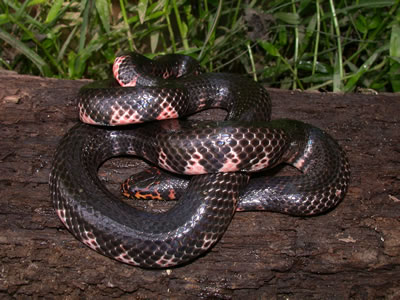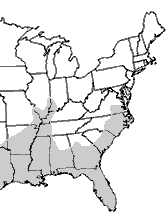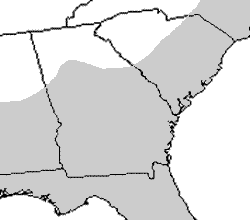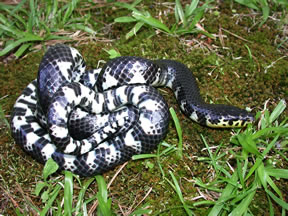Mud Snake (Farancia abacura)
Eastern Mud Snake (Farancia abacura)



Description: A large, heavy-bodied, highly aquatic snake reaching up to 207 cm (81 in). Dorsum glossy black with a red or pink-and-black checkerboard belly; red often extends up the sides. Head may show some yellow coloration, and eyes are small and dark. Scales are smooth and shiny, with a divided anal plate (though some individuals at the Savannah River Site show double anal plates). The tail ends in a sharp, spine-like tip, giving rise to the nickname “horn snake.” Males are smaller than females but have relatively longer and thicker tails. Juveniles resemble adults but often show more extensive red along the sides, sometimes appearing banded. Anerythristic (red-free) individuals are not uncommon in the Southeast.
Range and Habitat: Occurs in the Coastal Plain of the southeastern United States, from southern Virginia through Florida, west to eastern Texas, and north up the Mississippi drainage to southern Illinois. In Georgia and South Carolina, generally confined to the Coastal Plain but extending into the western Piedmont. Occupies diverse aquatic habitats, including seasonal wetlands, Carolina bays, cypress swamps, marshes, ditches, slow-moving streams, and vegetated pond margins. Juveniles are often found in temporary wetlands, while adults frequent more permanent waters. Despite their aquatic nature, they may travel long distances overland between wetlands.
Habits: Secretive and seldom observed, mud snakes spend most of their lives concealed among aquatic vegetation or debris. Rarely bask out of water, unlike many watersnakes. Most often encountered crossing roads near wetlands on rainy summer nights. When handled, they do not bite but may harmlessly press their tail spine into the captor. Adults feed primarily on giant aquatic salamanders (Amphiuma and Siren), while juveniles may also take tadpoles and salamander larvae. Females deposit eggs in sandy soils near water in early summer and sometimes remain with the clutch until hatching. Large females may lay over 100 eggs, though 20–30 is typical. Hatchlings emerge in late summer but may overwinter in the nest before dispersing.
Conservation Status: Although seldom seen, mud snakes are fairly common where suitable habitat persists and are not protected across most of their range. In Georgia, however, they are legally protected. Their reliance on wetlands and amphibian prey makes them vulnerable to habitat loss and wetland degradation.



